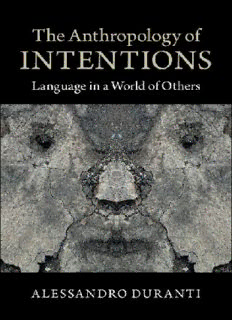
The Anthropology of Intentions: Language in a World of Others PDF
Preview The Anthropology of Intentions: Language in a World of Others
The Anthropology of Intentions Howandtowhatextentdopeopletakeintoaccounttheintentionsofothers? AlessandroDurantisetsouttoanswerthisquestion,showingthattheroleof intentionsinhumaninteractionisvariableacrossculturesandcontexts. Through careful analysis of data collected over three decades in US and Pacific societies, Duranti demonstrates that, in some communities, social actors avoid intentional discourse, focusing on the consequences of actions ratherthanontheirallegedoriginalgoals.Inothercases,heargues,peopledo speculateabouttheirownintentionsorguesstheintentionsofothers,includ- inginsomesocietieswhereitwaspreviouslyassumedtheyavoiddoingso. Toaccountforsuchvariation,Durantiproposesan“intentionalcontinuum,” aconceptthatdrawsfromphenomenologyandthedetailedanalysisofface- to-faceinteraction. A combination of new essays and classic re-evaluations, the book draws together findings from anthropology, linguistics, and philosophy to offer a penetratingaccountoftheroleofintentionsindefininghumanaction. alessandro duranti isDistinguishedProfessorofAnthropologyatthe UniversityofCalifornia,LosAngeles. The Anthropology of Intentions Language in a World of Others Alessandro Duranti UniversityPrintingHouse,CambridgeCB28BS,UnitedKingdom CambridgeUniversityPressispartoftheUniversityofCambridge. ItfurtherstheUniversity’smissionbydisseminatingknowledgeinthepursuitof education,learningandresearchatthehighestinternationallevelsofexcellence. www.cambridge.org Informationonthistitle:www.cambridge.org/9781107652033 ©AlessandroDuranti2015 Thispublicationisincopyright.Subjecttostatutoryexception andtotheprovisionsofrelevantcollectivelicensingagreements, noreproductionofanypartmaytakeplacewithoutthewritten permissionofCambridgeUniversityPress. Firstpublished2015 PrintedintheUnitedKingdombyClays,StIvesplc AcataloguerecordforthispublicationisavailablefromtheBritishLibrary LibraryofCongressCataloguinginPublicationdata Duranti,Alessandro. Theanthropologyofintentions:languageinaworldofothers/AlessandroDuranti. pages cm ISBN978-1-107-02639-1(Hardback)–ISBN978-1-107-65203-3(Paperback) 1. Anthropologicallinguistics. 2. Languageandculture. 3. Intention. I. Title. P35.D8572014 306.440089–dc23 2014023513 ISBN978-1-107-02639-1Hardback ISBN978-1-107-65203-3Paperback CambridgeUniversityPresshasnoresponsibilityforthepersistenceoraccuracyof URLsforexternalorthird-partyinternetwebsitesreferredtointhispublication, anddoesnotguaranteethatanycontentonsuchwebsitesis,orwillremain, accurateorappropriate. Contents List of figures page ix Acknowledgments xi 1 Rethinking anti-intentionalism 1 1.0 Introduction 1 1.1 Reopeningadialoguethatnevertookoff 2 1.2 Selfandother 5 1.3 Ethnopragmatics 6 1.4 Themes,issues,andintellectualconnections 7 1.5 Titleandexpectations 8 2 Intentions inspeaking andacting: the StandardTheory andits foes 11 2.0 Introduction 11 2.1 TheStandardTheory:Grice,Austin,andSearle 11 2.1.1 Thespeechactofpromising 12 2.1.2 Searle’sfivetypesofspeechactsandthenotionof“directionoffit” 14 2.1.3 Searle’smodelofintentionality 16 2.1.4 Searle’snotionsofNetworkandBackground:capturingimplicitcultural knowledge 17 2.2 Theroleofintentionindefining“action” 19 2.2.1 Unintendedconsequencesandthepracticalengagementwiththeworld 20 2.3 MichelleRosaldo’scritiqueofspeechacttheory 22 2.4 Brentano’sandHusserl’suseofintentions 25 2.5 CriticismofHusserl’suseofintentionalityasthefoundationofmeaning-making 27 2.5.1 Husserl’s“passivesynthesis”and“streaminglivingpresent”inthe unpublishedmanuscripts 29 2.6 Adifferenttheoristofspeechasaction:LudwigWittgenstein 30 2.7 Themeaningofintentionandintending 31 2.7.1 Translatingintention:anexerciseinSamoanethnopragmatics 33 2.8 Notgivinguponintentions 38 2.9 Alternative“western”ways 40 3 The avoidance of intentional discourse: aSamoan case study 43 3.0 Introduction 43 3.1 Avoidanceofmakingexplicitintentionsandmotivations 44 3.1.1 The1978–79project:Samoanlanguageacquisitionandsocialization 45 3.1.2 TheLaboratoryofComparativeHumanCognition:neo-Vygotskian perspectives 46 v vi Contents 3.2 AbriefintroductiontotheSamoanfonoasaspeecheventandasocialdrama 48 3.3 Unintendedconsequences:Loa’scase,April7,1979 51 3.3.1 Loa’sdefense 60 3.3.2 Therelevanceofpositionalroles 62 3.4 Absoluteliability,culturalpreference,andempiricalevidence 63 3.4.1 Causes,reasons,andsources 64 3.5 Conclusions 67 4 The invention ofpromising inthe Samoan translation ofthe Bible 69 4.0 Ispromisingahumanuniversal? 69 4.0.1 PromiseandpromisinginEnglish 71 4.1 Theinventionofpromising 72 4.1.1 SearchingforpromisinginSamoantextsanddictionaries 75 4.2 SamoantranslationofEnglishpromiseindictionaries 77 4.3 ChallengesinthetranslationoftheBibleintoSamoan 80 4.3.1 TranslationsfortheChristiannotionsof“soul”and“spirit” 84 4.4 TranslationsofpromiseintheBible 88 4.4.1 DifferencesbetweentranslationsofpromiseintheOldand NewTestaments 90 4.5 Promisesinnon-ChristianSamoantexts 92 4.6 Thecaseofthewordmāvaega 95 4.7 Promises,oaths,andpublicannouncements 96 4.8 Conclusions 98 5 Intentionalityand truth, revisited 101 5.0 Introduction 101 5.0.1 Anthropologicalthinkingandwriting 101 5.1 Truthascorrespondencebetweenthemindandtheworld 104 5.2 Intentionalityasarelationbetweenthemindandtheworld 107 5.3 Thereconstructionistmodelofinterpretation 107 5.4 Someproblemswithgoals,plans,andintentions-to-do 109 5.5 Code-relatedlimitsonspeaker’sintentions 111 5.5.1 Anexampleofhowagenreconstrainswhataspeakercansay 114 5.5.2 Audienceco-participationinshapingintentions 118 5.5.3 Culture-specificconstraintsonintrospectionandresponsibility 120 5.5.4 Multiplicityofgoals 121 5.6 Problemswiththetruth-functionalmodel 123 5.6.1 Truthandturn-taking 125 5.7 Truthandaffect 128 5.8 Truthandmetacommunication 130 5.9 Truthandaction 131 5.10 Conclusions 133 6 Speaker intentions and therole of theaudience in apolitical campaign inthe US 135 6.1 Thediscoveryofwhatwemean 135 6.2 TheCapps-for-CongressCampaign 137 6.3 Whentheaudiencehasadifferenttake 137 6.3.1 Controllingunintendedhumor 138 6.3.2 Canoneattackwithout“beingmean”? 144 6.4 Conclusions 148 Contents vii 7 Adialogue onintentions 151 with teun a. van dijk and t. jason throop 7.0 Introduction 151 7.1 November1,2004:fromvanDijktoDuranti 151 7.2 November2,2004:fromDurantitovanDijk 152 7.3 November2,2004:fromvanDijktoDuranti 154 7.4 November8,2004:fromDurantitovanDijk 158 7.5 November9,2004:fromvanDijktoDuranti 163 7.6 November16,2004:fromThrooptoDuranti(andvanDijk) 167 7.7 November16,2004:fromvanDijktoThroopandDuranti 171 7.8 Conclusions 173 8 Opacity ofother minds: local theories revisited 175 8.0 Introduction 175 8.1 Levelsofargumentation 176 8.2 Opacityofothermindsasaproblem 179 8.3 Contextualvariationandinconsistenciesintheethnographicaccounts 179 8.4 Examiningspontaneousinteraction 180 9 Intentions and their modifications: a lesson from Husserl 187 9.0 Introduction 187 9.1 Husserl’sintentionalityandtherelationshipwiththemodificationofattention 187 9.2 Phenomenalmodifications:theconstitutionoflinguisticacts 188 9.3 Intentionalmodifications 189 9.3.1 Instigatingintentionalmodificationsinjazzstudents 192 9.4 The“naturalattitude” 197 9.5 The“theoreticalattitude” 198 9.5.1 Thetheoreticalattitudeintalktoandbychildren 201 9.6 Modificationsandtheirroleinsocialization 206 10 Asense ofthe other:from intentionality tointersubjectivity 209 10.0 Introduction 209 10.1 Beyondindividualintentionsinhumanaction 210 10.2 Searle’snotionof“collectiveintentionality” 212 10.2.1 The“Background”andthe“Horizon” 215 10.2.2 Peopleinthepark 217 10.2.3 Theparadoxofcollectiveaction:moreplanning,lesspro-socialbehavior 218 10.3 Sociallydistributedcognitionandextendedminds 219 10.4 Followingrules 221 10.5 Spontaneityandimprovisation 222 10.5.1 Naturalizingintentions 223 10.5.2 Embodiedintentions:jazzimprovisation 223 10.6 Husserl’stheoryofperceptionasanticipationoftheviewingofanOther 228 10.7 Oureverydayunderstandingofothers 230 10.8 Conclusions 231 11 The intentional continuum 233 11.0 Introduction 233 11.1 Themeaningofintentionsandtheiruses 233 11.1.1 Matchingtheorywithsomeethnographicandlinguisticdata 235 11.2 The“intentionalcontinuum” 238 viii Contents 11.3 Hypo-cognitionofintentionsandhyper-cognitionofperlocutionaryeffects 240 11.4 Theperformanceofinterdependence 241 11.5 Individuals,socialcoordination,andsocialcontrol 242 Appendix A: Transcription conventions for English examples 243 Appendix B: Transcription conventions and abbreviations used in theSamoan examples 245 Notes 248 References 267 Index 293 Figures 2.1 The same Subject (A) can be directed toward thesame Object (G) through two different intentional acts: looking and worrying. page 26 3.1 Orators (onthe left) anda chief (on the right) during a fono (photoby A. Duranti, Falefā, `Upolu, Western Samoa, 1988) 49 3.2 Map ofsectionof Anoama`a East where Falefāis located, in the Atua district, ofwhichLufilufi isconsidered the capital and historical center (adapted from Krämer 1902: 704–705) 52 3.3 Three types offono inFalefā, eachdefined bythe number of participating subvillages (from Duranti 1981a: 40) 54 4.1 Title page of 1887 edition of the Tusi Paia, theSamoan translation of theBible, acollaborativeeffortby George Pratt,HenryNisbet, and others 83 5.1 Truth ascorrespondence between mindand world 105 5.2 Interpretation as correspondence between aproposition and a state-of-affairs 105 5.3 Two possible relations betweena proposition and the state-of-affairs it describes 107 5.4 The same Subject (A) can be directed toward thesame Object (G) throughdifferent intentional acts, e.g., admiration,fear 108 6.1 WalterCappsspeaking toa group ofsupporters in PasoRobles, California, November 15, 1995, saying “How do Iknow that?” 139 6.2 WalterCappsspeaking inSan Luis Obispo, November 15,1995, saying“How do we knowwe’re gonna win?” 141 6.3 WalterCappsspeaking atHancock College, Santa Maria, November 15, 1995, saying “I think thereason we’regonna win ...” 143 6.4 WalterCappsspeaking onthe campusof theUniversity of California, Santa Barbara, November 15, 1995,saying “this super-charged political rhetoric that ...” 149 9.1 The same Subject (A) isdirectedtowardthe same Object (G) at time t1in theintentional act of admiration and attime t2 inthe intentional act offear 191 ix
Description: